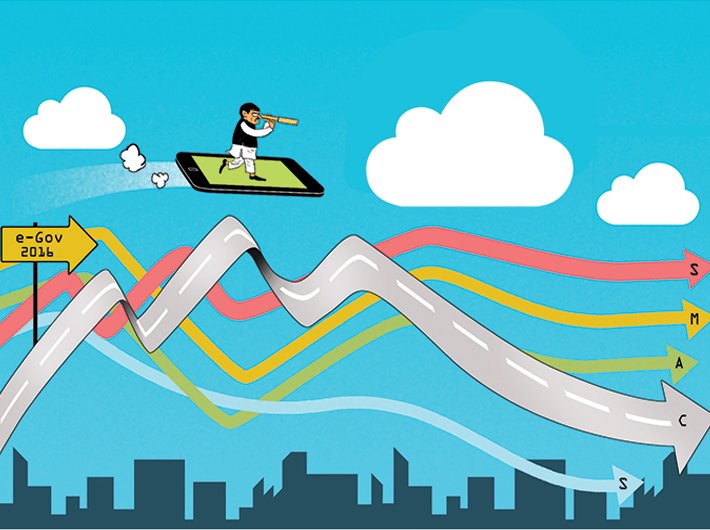It would most certainly be a year of awareness building and brick-laying, but it could disappoint the ultra-optimists who are hoping to see some big-ticket transformations happening overnight
It’s the beginning of a new calendar year and as is customary, I’m engaging in a bit of crystal ball gazing, though with an active disclaimer that I’m no scryer.
Looking back, 2015 was a landmark year from an e-governance standpoint even for one simple reason that it saw the unveiling of the Digital India project in July, followed by the Digital India week. It would be worth recalling that the event saw the corporate world committing a total of around '4.5 lakh crore in support of the government-led initiative.
Such is the scale and potential expanse of Digital India that one could go to the extent of assuming that its progress alone could be made a necessary and sufficient measure of e-governance efficacy in 2016. As a corollary to that assumption, it would suffice to assess how the essential ingredients of digitisation would be shaping up in 2016 and we could safely arrive at some key e-governance predictions for the next year.
Assessing the digital components
Any digital engine is typically known to comprise four to five essential components — social, mobility, analytics, cloud and sensors or SMACS for the acronym-happy. So let’s start with gauging the current state of these components and then make an assessment of how much these would possibly advance in the next year.
Social: It is a no-brainer that the social media performances of most of the government departments would still be categorised as low. Ironically enough, this is at a time when various political parties and their key leaders have rapidly evolved into being social media-savvy. Some of these leaders are not only parliamentarians and legislatures but also ministers at the central and state governments. The prime minister and some of the chief ministers are known to be remarkable effective social-media communicators. Clearly, their rub-off effects on the ministries and departments they head have been little. It would require a cultural change for social media to become an integrated channel for various e-governance programmes.
Mobility: As we know, there is a big difference between using a mobile device and actively embracing mobility as a productivity booster. While it is quite common to see government officials and other employees using smartphones with much dexterity for personal needs, the usage of these devices for official use is yet to become equally commonplace. Statistically speaking, around 43 percent respondents in a recently concluded Governance Now-B&M Nxt survey said smartphone users accounted for more than 75 percent of the employees in their (government) offices. However, a mere eight percent respondents said more than 75 percent of smartphone users were requiring access to cloud-based office productivity apps on their mobile devices. A dramatic upending of the currently state of mobility in the government is unlikely within the next year. The government’s Mobile Seva AppStore portal hasn’t really taken off, with a mere 389,878 cumulative downloads for 666 apps on the store.
Analytics: Again, much needs to be done to get the analytics piece right and functionally effective. One of the most crying need for application of big data analytics is in the area of agriculture, with the never-ending farmer suicides having become a social curse. At the same time, hundreds of tons of food grains are spoiled every year, just due to inadequacies in the storage and distribution systems and processes. These, and other various incidents, are a testimony to the fact that the vast repositories of government data are still far from being fed into analytics engines that in turn feed into various e-governance processes and programmes. As noted in an earlier column here, a multi-tiered big data solution could help address the three issues of procurement, storage and distribution in the area of agriculture. Similarly, solutions could be applied to help improve state of affairs in other sectors and citizen-facing matters as well.
Cloud: Well, on the face of it, much seems to have happened on the ground. It’s been around two years when the GI Cloud initiative Meghraj was launched and even though it is stated that around 250 government departments are availing the services, the usage is still understood to be of a nascent nature. In the Governance Now-B&M Nxt survey, 40 percent respondents said the use of public cloud-based office productivity applications was yet to be started while another 28 percent said the use of cloud was still at a very nascent stage. However, respondents also noted that security and compliance issues were among the key inhibitors of public cloud adoption in the government and that in-country location of the cloud data centres would significantly address the issues. With some global software vendors like Microsoft setting up their cloud data centres in India, a major step in the direction has been taken and this could bode well for an increased adoption of cloud in the coming year. However, awareness remains another inhibitor that would need to be overcome before significant progress is made.
Sensors: These refer to the more famed moniker, Internet of Things (IoT), and would be fundamental to the success of projects like the smart cities. It goes without saying that nearly all of the ten core infrastructure elements listed out in the mission statement and guidelines document on smart cities from ministry of urban development would need to rely heavily on sensors. These elements include water supply, sanitation and waste management, urban mobility and public transport, health and education, and public safety and security. For civic authorities to take timely and informed decision in a proactive (read smart) manner, tens of millions of sensors would need to form a smart grid. Looking at the current state of crisis-like scenarios in essential citizen facing areas like water supply and waste management, things don’t look much promising in general. Any progress that the first batch of smart cities makes in this regard should be seen as an exception and not the rule.
Looking ahead
The quick analysis of the SMACS stack implies that Digital India wouldn’t likely make notably rapid strides in 2016 from where it is now and consequently the same applies to the state of e-governance. However, there are likely to be pockets of excellence, which could serve as benchmarks and guiding lights for other projects.
The state of Andhra Pradesh, for example, is holding much promise with a clear thrust on projects like ePragati and the goal of achieving complete e-governance by 2017. Then there are states like Gujarat and Karnataka, which have been frontrunners in the area of e-governance and the ones like Maharashtra, Jharkhand, Madhya Pradesh, Goa, Assam and Nagaland that have come forward to study and adapt the successful projects from the frontrunner states. Also, the smart cities would likely form their own leagues of excellence.
All of this would certainly help build the momentum towards a wide-scale digitisation of governance in the coming years but fall short of being the phenomenon itself.

